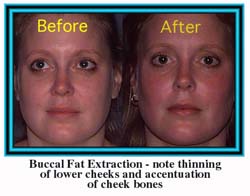Although chubby cheeks are adorable on little children, many adults find them to be a detraction from their overall appearance. Patients may request surgery to thin out the cheeks and change a round shaped face to a more oval appearance.
 Several procedures can be used to bring about this change. One way, although indirect, is to build up the cheekbones to emphasize the upper face. This is very useful, especially when the patient is naturally deficient in cheekbone projection. Cheekbone augmentation, a very popular procedure, is discussed elsewhere in this booklet. On other occasions, liposuction of the jowl area can be helpful.
Several procedures can be used to bring about this change. One way, although indirect, is to build up the cheekbones to emphasize the upper face. This is very useful, especially when the patient is naturally deficient in cheekbone projection. Cheekbone augmentation, a very popular procedure, is discussed elsewhere in this booklet. On other occasions, liposuction of the jowl area can be helpful.
A more direct approach is to actually remove fat from the area of the cheeks. In some patients, micro-liposuction surgery can help provide the answer. Through a small opening made beneath the ear, under the chin or just above the ear, very small cannulas, or hollow tubes, can be used to suction away the excess fatty tissue beneath the skin.
In other patients, the fatty deposits are located at a deeper layer and it is here that an operation called buccal fat extraction may prove most useful. To understand this operation we must consider the anatomy of the fat deposits in the face.
CHEEK ANATOMY
In its simplest terms, we can think of several layers of tissue in the cheeks. Of course, on the outside, we have the skin. Beneath that is a layer of fatty tissue of variable thickness. It is this layer that we treat with liposuction surgery. Just beneath the outer fatty tissue are sheets of muscle that allow us to create the expressions of the face and also assist in chewing and holding food in our mouth. Further inside is additional fat, which is called the buccal fat pad. Since this fat is actually beneath sheets of muscle, it is best to approach it from inside the mouth. The operation is carried out by making a very tiny incision inside the mouth between the upper molar and the cheek. Forceps are used to grasp the fat that is then removed through this tiny opening. In typical cases the amount of fat removed is about the size of a golf ball.
RISKS OF SURGERY
Risks include bleeding, infection or possible nerve injury that can produce weakness in the face. Complications are uncommon with this surgery and usually respond to treatment or diminish with time.
RESULTS OF SURGERY
After surgery, patients can expect a fair amount of swelling in the cheeks for several days. After that, there is a slow but progressive thinning appearance, which may take a month or so until it is fully revealed. After healing, patients can expect a distinct thinning of the chubby cheek look. While the effects are usually not dramatic, they are often significant, and patient satisfaction with the procedure is high when used for appropriate indications. Although we have described separate procedures used to treat this problem, in many cases both buccal fat extraction and liposuction will be combined to improve or enhance the overall effect. While not suitable for every patient, these techniques give the cosmetic surgeon additional tools which can be used to create a more pleasing appearance of the face.

